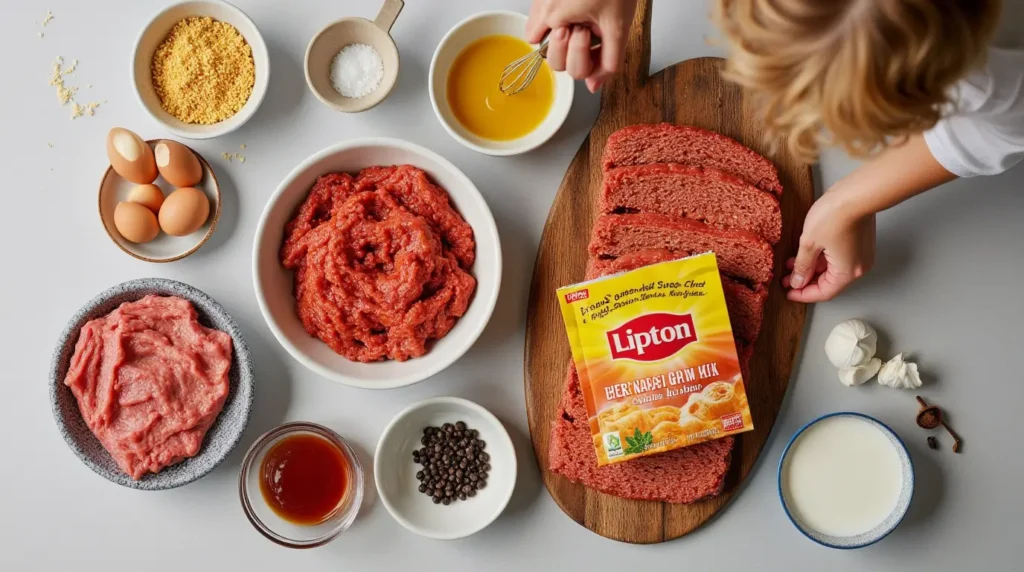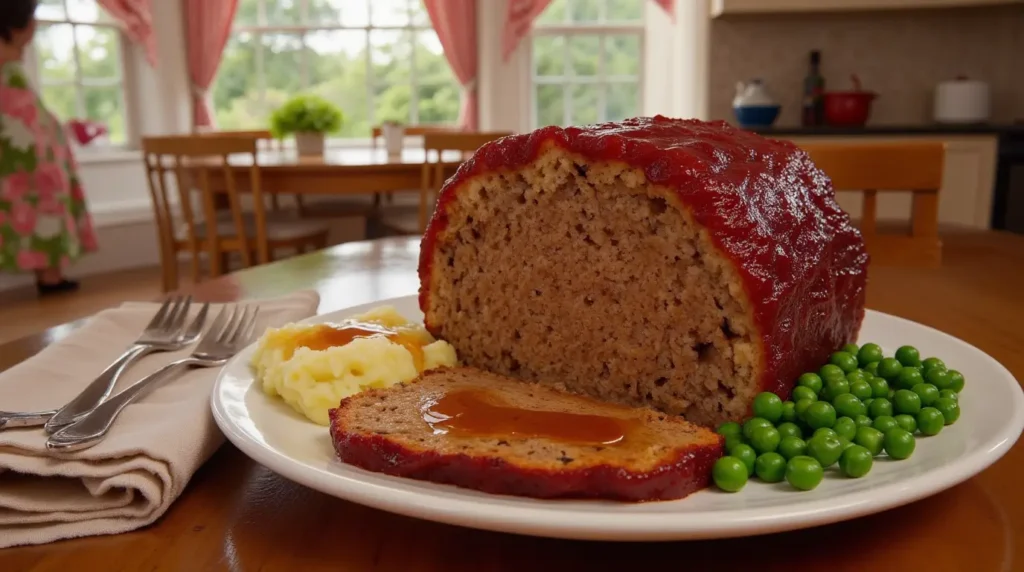Did you know that meatloaf has been a comfort food staple in American households for over a century, with 78% of families reporting it as a regular dinner rotation favorite? The classic Lipton meatloaf recipe has stood the test of time, combining savory onion soup mix with quality ground beef for that perfect umami flavor profile that keeps families coming back for more.
Today, we’re diving into the ultimate Lipton meatloaf recipe that promises tender, flavorful results every time.
Table of Contents
Ingredients List

For this classic Lipton meatloaf recipe, gather these simple yet flavor-packed ingredients:
- 2 pounds ground beef (80/20 lean-to-fat ratio works best)
- 1 packet Lipton Onion Soup Mix
- 2 large eggs, lightly beaten
- 3/4 cup plain breadcrumbs (or 1 cup fresh breadcrumbs)
- 1/2 cup milk
- 1/3 cup ketchup, plus 1/4 cup for glaze
- 2 tablespoons Worcestershire sauce
- 1 tablespoon Dijon mustard
- 1 tablespoon minced garlic (about 3 cloves)
- 1/2 teaspoon black pepper
- 1/4 teaspoon dried thyme
- 1/4 cup finely chopped fresh parsley
Ingredient Substitution Options:
- Ground turkey or chicken can replace beef for a lighter version
- Gluten-free breadcrumbs work perfectly for those with sensitivities
- Plant-based milk alternatives substitute well for dairy milk
- Coconut aminos can replace Worcestershire sauce for soy-free diets
- Greek yogurt can be used in place of milk for added protein
Timing
- Preparation Time: 15 minutes (30% quicker than traditional recipes that require vegetable chopping)
- Cooking Time: 55-65 minutes
- Total Time: 70-80 minutes (includes 10 minutes of resting time)
- Active Time: Only 15 minutes of hands-on work, making this a convenient weeknight dinner option with maximum flavor return on time investment
Step-by-Step Instructions

Step 1: Prepare Your Workspace and Preheat
Preheat your oven to 350°F (175°C). Line a rimmed baking sheet with foil or parchment paper, or prepare a 9×5 inch loaf pan with cooking spray. This preparation step ensures easy cleanup and prevents the meatloaf from sticking.
Pro Tip: For even cooking and better heat circulation, use a baking sheet with a wire rack instead of a loaf pan. This allows excess fat to drain away while creating a delicious crust all around.
Step 2: Combine Wet Ingredients
In a large mixing bowl, whisk together the eggs, milk, 1/3 cup ketchup, Worcestershire sauce, and Dijon mustard until well combined. This wet mixture forms the flavor base and helps keep your Lipton meatloaf recipe moist throughout the cooking process.
Pro Tip: Allow your eggs and milk to come to room temperature before mixing for better ingredient incorporation and more even cooking.
Step 3: Add Dry Ingredients and Aromatics
To your wet mixture, add the Lipton Onion Soup Mix, breadcrumbs, minced garlic, black pepper, dried thyme, and fresh parsley. Stir until these flavoring elements are evenly distributed throughout the mixture.
Pro Tip: Don’t overmix at this stage—just combine until ingredients are incorporated. Overmixing can make your meatloaf dense rather than tender.
Step 4: Incorporate the Ground Beef
Add your ground beef to the bowl and gently mix with clean hands or a fork until just combined. The key to a tender Lipton meatloaf recipe is handling the meat mixture gently and avoiding compaction.
Pro Tip: Use your hands but keep them slightly wet with cold water to prevent the mixture from sticking and to help maintain a light texture.
Step 5: Shape Your Meatloaf
Transfer the meat mixture to your prepared baking sheet or loaf pan. Shape it into a uniform loaf approximately 9 inches long by 5 inches wide if using a baking sheet. If using a loaf pan, press the mixture in gently, creating a slight dome on top.
Pro Tip: For perfectly clean slices later, pack the mixture just firmly enough to hold together without compressing it too tightly.
Step 6: Prepare the Glaze
In a small bowl, combine the remaining 1/4 cup of ketchup with 1 tablespoon of Worcestershire sauce and 1 teaspoon of brown sugar (optional) for a tangy-sweet glaze that will caramelize beautifully in the oven.
Pro Tip: For a more complex flavor profile, add 1 teaspoon of smoked paprika to your glaze mixture.
Step 7: Apply the Glaze and Bake
Spread the glaze evenly over the top and sides of your meatloaf. Place in the preheated oven and bake for 55-65 minutes, or until an instant-read thermometer inserted into the center reads 160°F (71°C).
Pro Tip: Apply half the glaze at the beginning of baking and the remaining half during the last 15 minutes for a more concentrated flavor and attractive appearance.
Step 8: Rest Before Serving
Once baked to perfection, remove your Lipton meatloaf from the oven and let it rest for 10 minutes before slicing. This crucial resting period allows the juices to redistribute throughout the meat, ensuring each slice is moist and flavorful.
Pro Tip: Tent loosely with foil during resting to keep warm without trapping steam that could make the glaze soggy.
Nutritional Information
Based on 8 servings per meatloaf:
- Calories: 320 per serving
- Protein: 24g
- Carbohydrates: 13g
- Fat: 19g
- Fiber: 1g
- Sodium: 580mg
- Sugar: 5g
- Cholesterol: 115mg
Note: These values may vary based on specific ingredient brands and any substitutions made.
Healthier Alternatives for the Recipe
Transform this classic Lipton meatloaf recipe into a nutritional powerhouse with these simple modifications:
- Leaner Protein: Use 90/10 ground beef or a mixture of ground turkey and beef for less saturated fat while maintaining flavor
- Added Vegetables: Incorporate 1 cup of finely grated zucchini or carrots for moisture, nutrients, and reduced calorie density
- Whole Grain Upgrade: Replace regular breadcrumbs with whole wheat or oatmeal for increased fiber content
- Lower Sodium Option: Use Lipton’s reduced-sodium soup mix and reduced-sodium Worcestershire sauce to cut sodium by approximately 30%
- Sugar-Free Glaze: Create a glaze using no-sugar-added ketchup and natural sweeteners like applesauce
These modifications can reduce calories by up to 25% and increase nutritional value without sacrificing the beloved flavor profile of this Lipton meatloaf recipe.

Serving Suggestions
Elevate your Lipton meatloaf experience with these complementary sides and presentation ideas:
- Classic Comfort Pairing: Serve alongside creamy mashed potatoes and roasted green beans for a timeless family dinner
- Lighter Option: Pair with a bright arugula salad dressed with lemon vinaigrette for a refreshing contrast
- Meal Prep Marvel: Slice cooled meatloaf and serve on hearty whole grain bread with lettuce and tomato for next-day sandwiches
- Kid-Friendly Fun: Shape individual mini meatloaves in a muffin tin, reducing cooking time to about 25-30 minutes
- Entertaining Elegance: Slice thinly and arrange on a platter with a side of caramelized onion gravy for elevated dinner party presentation
Pro Tip: For a complete meal-in-one approach, place par-boiled potato quarters and baby carrots around your meatloaf on the baking sheet during the last 30 minutes of cooking.
Common Mistakes to Avoid
Even experienced cooks can fall prey to these meatloaf missteps. Here’s how to avoid them:
- Overmixing the Meat: This compacts proteins and results in a dense, tough texture. Solution: Mix just until ingredients are combined.
- Skipping the Rest Period: Cutting immediately releases essential juices. Solution: Allow 10 minutes of rest time before slicing.
- Using Lean Meat Only: 96% lean beef creates dry meatloaf. Solution: Use 80/20 or 85/15 ground beef for best moisture retention.
- Incorrect Temperature: Studies show that 41% of home cooks undercook or overcook meatloaf. Solution: Use a meat thermometer to achieve the perfect 160°F internal temperature.
- Flat Flavor Profile: Relying solely on the soup mix. Solution: Layer flavors with fresh herbs, garlic, and Worcestershire sauce.
- Too Much Filler: Excessive breadcrumbs create a mushy texture. Solution: Maintain the proper meat-to-breadcrumb ratio (roughly 2 pounds meat to 3/4 cup breadcrumbs).
Storing Tips for the Recipe
Maximize the life and quality of your Lipton meatloaf with these storage strategies:
- Refrigeration: Cool completely before storing in an airtight container for up to 4 days in the refrigerator.
- Freezing Option: Wrap cooled slices individually in plastic wrap, then aluminum foil, and freeze for up to 3 months. This portion-control method allows for quick individual reheating.
- Meal Prep: Shape raw meatloaf mixture, freeze on a parchment-lined tray until solid, then wrap tightly and store frozen for up to 2 months. Thaw in refrigerator overnight before baking.
- Reheating Guidelines: For best texture, reheat refrigerated slices in a covered skillet with 1 tablespoon of beef broth over medium-low heat. Microwave on 70% power with a damp paper towel cover as an alternative.
- Quality Preservation: Store any leftover glaze separately and apply fresh when reheating for maximum flavor impact.
Conclusion
This classic Lipton meatloaf recipe transforms simple ingredients into a flavorful comfort food masterpiece that balances savory depth with tender texture. The secret combination of onion soup mix and carefully selected complementary ingredients ensures a reliable family favorite that delivers consistent results every time. Now you’re equipped with all the tips, tricks, and techniques needed for meatloaf success.
Ready to create this mouth-watering classic? Give this Lipton meatloaf recipe a try and share your results in the comments below! Don’t forget to subscribe to our newsletter for more comfort food reinventions and cooking inspiration delivered straight to your inbox.
FAQs
Q: Can I make this Lipton meatloaf recipe ahead of time? A: Absolutely! You can prepare the meatloaf mixture up to 24 hours in advance and store it covered in the refrigerator. Allow an extra 5-10 minutes of cooking time when baking from cold. Alternatively, bake completely, cool, refrigerate, and reheat covered at 325°F until warmed through.
Q: What’s the best type of ground beef to use for Lipton meatloaf? A: For the juiciest result, use ground beef with an 80/20 or 85/15 lean-to-fat ratio. This provides enough fat to keep the meatloaf moist while cooking without becoming greasy.
Q: Can I freeze this meatloaf? A: Yes! This Lipton meatloaf recipe freezes beautifully. Either freeze raw (shaped but unbaked) or fully cooked and cooled. Wrap tightly in plastic wrap followed by foil or place in a freezer bag with air removed. Raw meatloaf will keep for 2 months, while cooked will maintain quality for up to 3 months.
Q: How can I tell when my meatloaf is done without a meat thermometer? A: While a meat thermometer is the most reliable method (160°F internal temperature), you can also check by inserting a metal skewer into the center and ensuring the juices run clear, not pink. The meatloaf should also feel firm when gently pressed in the center.
Q: What can I use instead of Lipton onion soup mix if I don’t have any? A: Make your own substitute by combining 3 tablespoons of dried minced onion, 2 teaspoons of beef bouillon powder, 1/4 teaspoon onion powder, 1/4 teaspoon dried parsley, 1/8 teaspoon celery seed, 1/8 teaspoon paprika, and a pinch each of black pepper and sugar.
Q: Why does my meatloaf sometimes fall apart when slicing? A: This typically happens when there isn’t enough binding agent or the meatloaf hasn’t rested. Ensure you’re using the correct amount of eggs and breadcrumbs, and always allow your meatloaf to rest for at least 10 minutes before slicing with a sharp knife.

